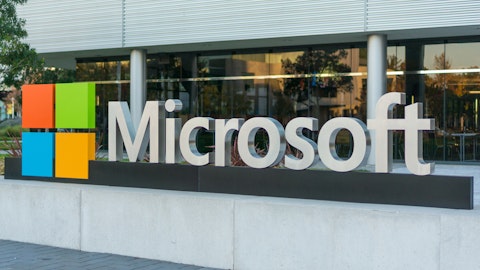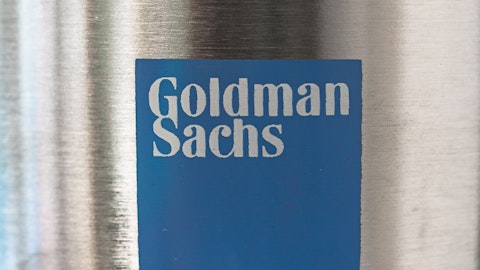It identifies what your various applications and devices are, and you’d sort of think, oh, well people would know, but they don’t. Enterprise, major enterprises just have zillions of applications and devices on the internal network and they don’t even know what they all are. And this tells you, in actually a human language form, can actually tell you what is not sufficiently protected or if the firewall rules, the agent rules are out-of-date. We’ve got a lot of positive feedback about that at RSA. And it’s something that over time we want to take to our entire suite of security services, which I think will be pretty exciting. So yeah, so this helps because customers want to see, really have a few basic platforms of which Akamai is one and simplification of interface and control, both for the control plane and for the agent that’s on their applications and service.
Jonathan Ho: Excellent, excellent. And just in terms of a follow-up, with compute, you obviously spoke about a number of large wins here, large types of customers. Can you talk about the potential to take that larger share of the pie over time as you grow within these customers and help us understand, are you landing in sort of a small footprint to begin with and then growing from there? Are you just sort of taking everything up front? I’m just trying to understand what that net retention opportunity looks like over time. Thank you.
Tom Leighton: Yeah, great question. It very much is a land small. Somebody will try out a single app with a little of the traffic forward and then grow it, and then add more apps. And you see that with our profile of customers, starting with the ones that $3,000 a month, then half of them now up to [$100,000] (ph) a year, [$60 million] (ph), [$100 million] (ph) a year. And Akamai is actually our first $100 million a year customer on the platform. And that’s the same progression we went through over the last year-and-a-half. And we expect, and that’s what we’re trying to do with all of our accounts. These customers I talked about I couldn’t give you most of their names, but you would recognize them. And they are — what they’re spending now with us is a tiny fraction, even the big ones, of their overall cloud spend.
And they are finding the platform is easy to use, performs very well, and is saving them a boatload of money. And I think that’s why we’re seeing such good early traction. And now the goal is to grow those accounts, both in terms of the number of use cases and the scale of a use case, and then to add more customers. And again, they will come in at the lower revenue volumes to start.
Operator: The next question comes from Alex Henderson from Needham. Please go ahead.
Alex Henderson: Great, thanks. First off, congratulations. Picking off Noname was a real coup for you. I think that’s an outstanding acquisition. So congratulations on that. I wanted to ask some content around the compute piece. First, you moved a bunch of your internal apps from other compute platforms to internal. Where are you on that? What does that look like in terms of the cost savings? And what has been the variance relative to what you’d expected when you started it, I assume you probably got better results, not worse results. And I was hoping you could, within the context of the compute platform, talk about gross retention as opposed to net retention. Obviously your net retention looks very good with these upticks, but I was wondering if there was any churn of people who were on the platform before that may have fallen out of the equation?
Tom Leighton: Yeah, we’re more than halfway through the migration of our third-party cloud spend onto Akamai Connected Cloud. And as I mentioned, seeing really dramatic savings and also performance improvements. So we’re more than $100 million a year in on the platform now, which is really fabulous for us. And maybe, Ed you want to take the second part of that question?
Ed McGowan: Yeah, so if you think about where you see that, Alex, is there some absolute savings if you look at our – in our cost of goods sold line, you can see that on that network build and support sub-line, sub-category. It’s offset a little bit by what you see in [colocation] (ph) fees. So you’re not seeing a ton of margin expansion. But what doesn’t show up there is that that line was growing at 30%, 40%, or 50% a year. Now, probably we’d be growing 30%, 40% if we hadn’t done it. So the cost avoidance is pretty significant. As Tom said, we’re finding this to be much better than we had expected. We should get the rest of the expected applications moved over here between now and the early part of next year, end of this year into the early part of next year.
So I’m very, very pleased with that. And again, a lot of cost avoidance and some absolute cost savings, like I said, being a little bit [massive] (ph), investments we’re making in the platform. And then you also asked a question on gross retention, I think was the term you used in terms of are we seeing any churn. On the enterprise side, we’re not seeing any churn so far. We haven’t seen any customers that have left the platform. We do see a little bit of churn in the legacy retail node business which was pretty common when you talked about the SMTs. But where we’re really aiming to grow the business, we’re not seeing any of that yet.
Alex Henderson: Okay, great. And just one last question on this subject. Can you talk about whether you’re seeing any potential around inference AI on this platform because it hasn’t been mentioned yet. Thanks.
Tom Leighton: Oh yeah, we already have several customers doing all sorts of AI, but inference AI on our platform, and we have partners, our ISV partners. Some of them, that’s their product capability. So yeah, we foresee substantial use of the platform for inference.
Alex Henderson: Great. Thank you.
Operator: The next question comes from Rudy Kessinger from DA Davidson. Please go ahead.
Rudy Kessinger: Hey, Thanks for taking my questions. Ed, just given the quicker than expected mix shift of the higher gross margin revenue lines, why aren’t we seeing gross margins at least hold steady, if not expand? It’s been compressing for the last few years.
Ed McGowan: Yes, so if you look back a few years ago, they’ve been compressing a bit. We had some pricing pressure as we always do in the delivery business. But I talked a little bit about this a few questions ago, and even a little bit with Alex in the last question. As we invest in the platform to build out compute locations, we’re doing the GECO build out. We built out 25 core locations last year. We entered into these long-term leases for colocation. And where there’s underlying [commits] (ph), you have to straight line that. So there’s some non-cash colocation expenses. So if you look at our [co-loc] (ph) cost line, that’s been growing pretty substantially. So that’s masking a lot of the savings that you’re seeing from our third-party compute costs.
There’s also additional build out and support costs that go along with it as well. So that’s why you’re seeing that margin sort of holding flat to where they’ve been over let’s say the last year or so, but I don’t expect them to decline. Hopefully over time they should start to expand a bit, but as we’re building out aggressively in the compute platform that does put a little bit of pressure on margins, but as we start to fill up those locations, we should start to see expansion in margin.
Rudy Kessinger: Yeah, okay. And then on delivery, could you just talk about where some of the repricings came in with some of those contracts? And if I look at kind of what’s implied for delivery in the rest of the year on an organic basis adjusting for some of those contracts you acquired, it looks like it kind of probably gets down to down 20%-ish year-over-year on an organic basis. What is the mix of price compression versus traffic growth? Is it flat kind of traffic on the network given all the things you talked about and 20% price compression or what is the combination there?
Ed McGowan: Yeah, so we don’t share those numbers for obvious reasons with the price compression because obviously there’s customers that get certain discounts, others don’t get as high discount because they don’t have as much traffic. And also it’s a competitive number. I’d want to know what my competitors are doing with that number as well. But if I think about sort of the mix of what’s driving it. Pricing is always a factor. And if you don’t get the commensurate traffic growth offset that, then you’re going to decline. And that’s what we’re seeing. It’s really the back-half story is a lower than expected traffic. Now, couple that with your, some of your largest customers renewing at the same time. You don’t have that, that volume offset. It just exaggerates the impact at the back half of the year. So like I said, it’s really more of a volume issue than it is an overall pricing issue.
Tom Leighton: Okay, operator, I think we’ve got time for one last question.
Operator: The next question comes from Tom Blakey from KeyBanc Capital Markets. Please go ahead.
Tom Blakey: Hey, Mark and guys, thanks for squeezing me in here. I just wanted to go back, I think maybe to dive a little deeper on Rudy’s question about gross margins. You talk about moving to more profitable solutions longer-term and made some headway here in one queue. In the past, you’ve kind of given us a framework about lowering CapEx, as a percentage of revenue for CDN. Essentially, 0% CapEx is needed, theoretically anyway, for security. Can you just walk us through what the — not the near-term manned price components are, but longer-term structurally, what does compute look like at scale for Akamai? And have a follow up.





